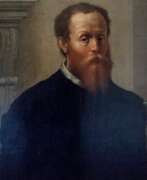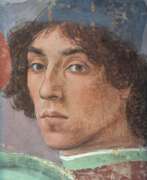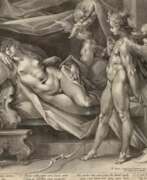Portraitist 16th century


Cristofano Allori was an Italian painter of the late Florentine Mannerist school, painting mostly portraits and religious subjects. Allori received his first lessons in painting from his father, Alessandro Allori, but becoming dissatisfied with the hard anatomical drawing and cold coloring of the latter, he entered the studio of Gregorio Pagani. When still young he became a court portraitist for the Medicis, though many of his commissions were replicas of portraits by his predecessor Bronzino, or had participation by others.[citation needed. His pictures are distinguished by their close adherence to nature and the delicacy and technical perfection of their execution. His most famous work, in his own day and now, is Judith with the Head of Holofernes.


Alessandro Allori, full name Alessandro di Cristofano di Lorenzo del Bronzino Allori, was an Italian painter of the Florentine school of late Mannerism.
Allori was one of the major artists of Florence in the late 16th century. He painted prostrate images and portraits. His son Cristofano Allori (1577-1621) also became an artist.


Christoph Amberger was a German painter of the Renaissance. He is known primarily as a portrait painter and is considered one of the most prominent masters of this genre of his generation.
Amberger built his career in the city of Augsburg, which was then considered one of the cultural centers of Europe. He painted numerous portraits of Augsburg patricians and their wives, prominent scholars, and the Holy Roman Emperor Charles V. These works laid the foundation for the artist's success. Amberger also designed the high altar of Augsburg Cathedral.


Hans Baldung, also known as Hans Baldung Grien, was a prominent figure in the German Renaissance, celebrated for his innovative approach to painting, printmaking, and drawing. Born around 1484 in Schwäbisch Gmünd, Germany, and passing away in 1545 in Strasbourg, France, Baldung's career was marked by a distinctive style that art historians have associated with the mannerist tendencies of the time. His work is notable for its exploration of themes such as the imminence of death, the complexities of human sexuality, and scenes of witchcraft, distinguishing him from his contemporaries with a bold and unique artistic voice.
Educated in the workshop of Albrecht Dürer, Baldung quickly developed his own artistic language, absorbing and then transcending Dürer's influence. He is particularly renowned for his altarpieces, portraits, and a series of works that delve into eroticism and the supernatural. Among his most significant contributions is the high altar of the Freiburg Münster, an eleven-panel masterpiece depicting scenes from the life of the Virgin Mary, which remains a testament to his mastery over religious subjects even as he ventured into more secular and profane themes.
Baldung's fascination with witchcraft and his portrayal of witches in art were groundbreaking for the time. His works in this area, such as "The Witches' Sabbath" and "Weather Witches," reveal a complex interplay of humanist thought, classical literature, and contemporary beliefs about witchcraft. They offer a nuanced perspective that blends satire with a deeper commentary on human nature and societal fears, marking Baldung as a pioneer in the visual exploration of these themes.
Despite his engagement with the themes of death and witchcraft, Baldung's oeuvre is also rich in portraits characterized by sharp individualization and psychological depth, as well as altarpieces that convey a profound spiritual and theological insight. His ability to navigate between the realms of the divine and the earthly, the solemn and the profane, solidifies his position as a versatile and innovative artist of the Renaissance.
For collectors and experts in art and antiques, Hans Baldung's work offers a unique window into the confluence of Renaissance artistry, humanist thought, and the socio-religious dynamics of early 16th-century Europe. His paintings and prints not only adorn museums and galleries worldwide but also continue to inspire and provoke deep reflection on the human condition.
To stay informed about new discoveries, exhibitions, and auction events related to Hans Baldung's art, signing up for updates can provide enthusiasts and collectors with valuable insights into the enduring legacy of this remarkable artist. This subscription service is designed to alert subscribers to new product sales and auction events specifically related to Hans Baldung, ensuring that they remain at the forefront of developments in the field of Renaissance art and antiques.


Simone Barabino was an Italian painter of the late-Mannerist style. Born in Val de Polcevera, near Genoa, he was mainly active in his native city, where he trained with Bernardo Castello. Notable works include San Diego restoring sight to blind child for the Nunziata del Guastato in Genoa and Dead Christ with the Virgin and Saints Michael and Andrew for the church of San Girolamo at Milan.


Nicolas Béatrizet (or Beatrizet, or Beatricetto) was a 16th century French engraver, working in Rome. Béatrizet was born at Luneville in or before 1520. From his style, it has been conjectured that he was a scholar of Ghisi and Agostino Veneziano de Musis. From 1540 to 1560, he engraved under the direction of Michelangelo. The importance of Béatrizet's works lay in the fact that his engravings were unique records of pictures by some of the greatest artists rather than their inherent quality. He usually signed his plates with the letters "N. B. L. F.". Their number is considerable, but most of them are included in the following list.
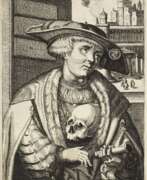

Jakob Binck / Bink, a German artist, was skilled in engraving, etching, painting, and medal making. He worked for various courts in Northern Europe, including the Danish court, and resided in Antwerp. Binck's artistic style resembled that of the Little Masters group. While it is believed he may have been a pupil of Dürer, his early residence in Italy casts doubt on this assumption. Binck's known paintings are primarily portraits, known for their accurate drawing and artistic taste.


Abraham Bloemaert was a Dutch painter, draughtsman, and printmaker from the Golden Age of Dutch painting, one of the founders of the Guild of St. Luke in Utrecht. Bloemart was a caravagist. He painted mainly landscapes, mythological and biblical scenes, and pastoral works.


Paul Bril was a prominent Flemish painter, best known for his significant contributions to landscape painting. Born around 1554 in Antwerp, he later moved to Rome, where he became a central figure in the art scene, influencing the Italian and Northern European landscape painting traditions.
Paul Bril's early works were steeped in the Flemish manner, exhibiting a picturesque arrangement of landscape elements with dramatic contrasts of light and dark. His style evolved during his stay in Rome, influenced by the work of Annibale Carracci and Adam Elsheimer. By around 1605, Bril's compositions became more serene and classical, showcasing calmer transitions from foreground to background and embracing pastoral and mythological themes.
Paul Bril's contributions extended beyond his paintings. He was a respected figure in Rome's art community, becoming the first foreign director of the Accademia di San Luca in 1621. His patrons included some of the most influential families in Rome, and his work was sought after by collectors and fellow artists. Bril's influence was profound, impacting future generations of artists, including the Dutch Italianates and genre painters active in Rome.
His works can be found in prestigious galleries worldwide, illustrating his enduring legacy in the art world. For collectors and art and antiques experts, Paul Bril's work represents a significant period in the evolution of landscape painting, blending Flemish traditions with Italian classicism.
For those interested in exploring the captivating landscapes and historical significance of Paul Bril's art, staying informed about new product sales and auction events is essential. Signing up for updates can provide valuable insights and opportunities to acquire pieces associated with this influential artist.


Agnolo di Cosimo di Mariano, also Agnolo Tori, called Bronzino was an Italian painter, an important representative of Mannerism.
Bronzino was a painter of frescoes, altarpieces, devotional paintings and allegorical and mythological scenes. However, he excelled above all as an outstanding portrait painter. As in the case of Raphael, his works could be disseminated through the new possibilities of printmaking.


Hans Brosamer was a German draughtsman, printmaker and painter of the Renaissance period. His life has left hardly any documentary trace, other than his prints. His works include over 600 woodcuts, mostly illustrations for books of various sorts, but also a number of independent prints. He produced 38 engravings (as listed by Hollstein), and a number of drawings, mostly with his monogram. As a painter, a number of portraits of figures from the local elites, normally at half-length, are attributed to him. On account of the small size of his engravings he is counted among the Little Masters, and many of these are rather derivative of others in the group, such as Jacob Binck and Heinrich Aldegrever, and of Lucas Cranach the Elder in his portraits.
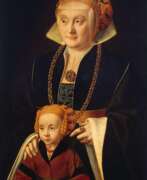



Carlo Cannovaro Caliari was an Italian artist of the Renaissance period. He is also known as Carletto. The youngest son of Paolo Veronese, Caliari was active mainly in Venice, where he worked and inherited the studio of his far more famous father, and later worked along with his brother Gabriele and his uncle, Benedetto.


Peter Candid was a Flemish painter, tapestry designer, draughtsman and sculptor.
Pieter Candide worked mainly in Italy and Germany. He was an artist at the court of the Medici in Florence and at the Bavarian court of Duke Wilhelm V and his successor Maximilian I in Munich.
His paintings range from historical paintings, portraits, mythological scenes and allegories. He created large altarpiece images as well as complex decorative designs.
Candide's style was characterised by a combination of Italian and Flemish influences, with a particular emphasis on detailed, realistic depictions of the human form.
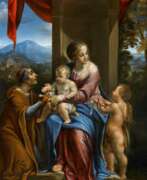

Angelo Caroselli was an Italian painter, born and active during the Baroque period, primarily in Rome. Known for his eclectic style, Caroselli's work was significantly influenced by Caravaggio, evident in the naturalism and chiaroscuro that marked his compositions. His subject matter often included colorful characters from contemporary Rome, scenes of witchcraft, musicians, and genre scenes reflective of the Caravaggisti, a group of artists who followed Caravaggio's stylistic approach. Caroselli's ability to blend allegories, religious works, and portraits with genre scenes showcased his search for originality and a unique narrative voice within the Baroque movement.
Angelo Caroselli's career was marked by his versatility as not only a painter but also an art restorer, copyist, and possibly a forger. This breadth of skills contributed to the diverse body of work he left behind, which ranged from scenes of everyday life to complex allegorical compositions. His works often depicted the lower echelons of society, including musicians, card players, and prostitutes, infused with a potent naturalism that brought these figures to life against the backdrop of 17th-century Rome.
Despite his adherence to Caravaggesque forms and themes, Angelo Caroselli's work also displayed 'archaicising' elements, which some art historians view as a conscious departure from the dominant Baroque style of his time. This aspect of his work, along with his skill in copying the works of ancient masters, highlights a deliberate exploration of and departure from the prevailing artistic norms, contributing to the unique place he occupies in Baroque art history.
Notably, Caroselli's influence extended beyond Italy, affecting the work of other Caravaggisti, including the Lucchese painter Pietro Paolini and the Dutch painter Dirck van Baburen. This cross-cultural impact underscores the broader significance of Caroselli's work within the Baroque period and its enduring influence on subsequent generations of artists.
His legacy includes several known works that are housed in prestigious institutions and collections worldwide, exemplifying the enduring appeal and historical importance of his artistic contributions. Among these, "The Plague at Ashdod (after Poussin)" stands out as a significant piece, reflecting his capability to engage with and reinterpret the works of his contemporaries and predecessors.
For collectors and experts in art and antiques, Caroselli's oeuvre offers a fascinating glimpse into the Baroque period's complexity, characterized by a blend of innovation, tradition, and a deep engagement with the human condition. His work remains a testament to the vibrancy and dynamism of 17th-century Italian art, inviting ongoing exploration and appreciation.
To stay updated on new discoveries, sales, and auction events related to Angelo Caroselli, sign up for our newsletter. This subscription ensures you're the first to know about the latest findings and opportunities to acquire works by or related to Angelo Caroselli, catering specifically to enthusiasts and collectors of historical art and antiques.


Vittore Carpaccio, an illustrious Italian painter, was a master of narrative storytelling and vivid detail, flourishing in Venice between 1465 and 1526. His specialization in religious and historical scenes set him apart, with a particular knack for infusing life and emotion into every brushstroke. Carpaccio's work exemplifies the Venetian School's richness, noted for its deep colors and intricate details that capture the viewer's imagination.
Carpaccio is renowned for his ability to weave intricate narratives through his paintings, often depicting scenes from the lives of saints with both devotion and a keen eye for daily Venetian life. His works are celebrated for their meticulous attention to architectural and costume details, offering a window into the Renaissance period's social and cultural contexts.
Among his known masterpieces, the cycle of paintings dedicated to the legend of Saint Ursula in the Scuola di San Giorgio degli Schiavoni in Venice stands as a testament to his narrative prowess and technical skill. These works, alongside others housed in prestigious galleries worldwide, underscore Carpaccio's significant contribution to the art world, making him a subject of admiration among collectors and art historians alike.
For those fascinated by the splendor of the Renaissance and the beauty of Venetian artistry, Vittore Carpaccio's oeuvre offers a rich tapestry of historical and religious narratives brought to life through his exceptional talent. His legacy continues to inspire and captivate, embodying the essence of one of the most vibrant periods in art history.
To delve deeper into the world of Vittore Carpaccio and stay informed about upcoming sales, exhibitions, and auction events featuring his work, signing up for updates is your gateway to the exclusive circle of Renaissance art enthusiasts. This subscription is a commitment to keeping you at the forefront of new discoveries and opportunities to enrich your collection with pieces by this Venetian master.


Annibale Carracci was an Italian painter and instructor, renowned for his influence in the transition from Mannerism to the Baroque style. Born into a humble family in Bologna, Annibale, alongside his brother Agostino and cousin Ludovico, founded the Accademia degli Incamminati, promoting a new artistic approach that combined a thorough study of nature with the study of previous art masters. This approach aimed to form a universal style, distinguishing their work from the mannered art of their contemporaries.
Annibale's work in Rome, especially his frescoes in the Palazzo Farnese, showcased his mastery of illusionistic elements, drawing inspiration from classical antiquity and the works of Michelangelo Buonarroti and Raphael. His work on the Galleria Farnese ceiling is particularly noted for its integration of classical ideals with dynamic Baroque energy, making it a seminal work in the evolution of Baroque art. His style influenced a myriad of artists, including Peter Paul Rubens, Nicolas Poussin, and Gian Lorenzo Bernini, and his approach to painting, emphasizing a blend of idealism with observational naturalism, set a new standard for European art.
Annibale Carracci's legacy extends beyond his frescoes; his genre paintings and landscapes were pivotal in elevating these forms to new prominence. His innovative techniques and thematic versatility have ensured his esteemed place in art history, influencing the trajectory of 17th-century European art.
For art collectors and experts, Annibale Carracci's works represent a pivotal moment in the evolution of European painting, showcasing a transition from the detailed naturalism of the Renaissance to the expressive dynamism of the Baroque. His influence is evident in the works of subsequent generations of artists, marking him as a figure of immense historical and artistic significance.
To stay updated on new product sales and auction events related to Annibale Carracci, consider signing up for our updates. This subscription will provide you with curated information pertinent to the legacy and art of Carracci, ensuring you remain informed about opportunities to engage with his enduring artistic influence.


Alessandro Casolani was an Italian painter of the late-Renaissance period, active mainly in Siena. He was also called Alessandro della Torre. His works are principally in the churches of Siena, but are also found in Naples and Genoa. He also etched one plate, a Madonna. His son, Ilario Casolani was also a painter. Among the pupils of Casolani are Bernardino Capitelli, Sebastiano Folli, and Giovanni Biliverti.


Giovanni Battista Castello was an Italian historical painter. His best-known works are the paintings on the vault of the Basilica della Santissima Annunziata del Vastato. He was an architect and sculptor as well as painter. He painted of the Martyrdom of St. Sebastian in the monastery of San Sebastiano. He worked on various projects with his friend Cambiaso, including in a chapel for the Duomo di San Lorenzo.


Bernardo Castello (or Castelli) was an Italian painter of the late-Mannerist style, active mainly in Genoa and Liguria. He is mainly known as a portrait and historical painter. He was apprenticed under Andrea Semino and Luca Cambiaso, then travelled throughout Italy, meeting other painters and creating his own particular style. During his career he painted many works and was appreciated by famous poets with whom he had friendships. Beside working in Genoa, Castello was employed in Rome and worked also for the Duke of Savoy, Charles Emmanuel I.


Bartolomeo Cesi was an Italian painter and draftsman of the Bolognese School. He made easel paintings as well as frescoes. He is known mainly for his religious paintings but he also painted portraits and mythological scenes.


Cornelis Cort, also known as Cornelio Fiammingo, was a Dutch engraver and draughtsman. He began his career in the Northern Netherlands, but later moved to Venice and lived in Titian's house. Cort produced engravings based on Titian's works and became renowned for his copperplates of various subjects. He traveled back and forth between Italy and the Netherlands, establishing a school in Rome and circulating works of famous artists. Cort's impressive output includes over 150 engravings.


Raphael Coxie was a Flemish Renaissance painter mainly known for his portrait and history paintings. Details about the life and career of the artist are sketchy. He was only rediscovered as a distinctive artist in the 19th century. He was a pupil of his father and became master in the Mechelen Guild of Saint Luke in 1562. Raphael was a passionate gardener and friend of the Flemish botanist Carolus Clusius to whom he sent drawings of flowers, which Clusius used in his scientific publications. He was active from 1586 in Brussels where he became a master of the local painter's guild in 1605. In the period 1588-89 he spent time in Ghent on a major commission for a painting of the Last Judgement. While in Ghent Coxie also painted a Resurrection of Christ for the monks of the Abbey of Drongen. He is recorded in 1597 as making, in collaboration with Gilbert van Veen, several portraits commissioned by Philip II of Spain.


Lucas Cranach the Younger was a German painter of the mid-16th century. He is known as a Renaissance painter and portraitist, one of the sons of the painter and graphic artist Lucas Cranach the Elder.
Cranach the Younger painted portraits and paintings of the mythological genre. Despite his lack of courtly status, he worked for the social elite, including princes and nobles. After the artist's death, his works were distributed to various churches, schools, castles and homes. As a member of the new generation, he favored rich and flamboyant images. Cranach the Younger is believed to have created a new artistic program for the Protestants.


Domenico Passignano, born Domenico Cresti or Crespi, was an Italian painter of a late-Renaissance or Counter-Maniera (Counter-Mannerism) style that emerged in Florence towards the end of the 16th century.


Giovanni Antonio da Brescia was an Italian Renaissance engraver who produced around 150 engravings, including those previously attributed to Zoan Andrea. He began his career under Andrea Mantegna in Mantua before settling in Rome and had an influence on Marcantonio Raimondi. His engravings mainly feature figures and use the burin and drypoint techniques. Giovanni Antonio's last known works were translations of painted works around 1519-1520, and some estimate his last production to be in 1525.


Polidoro Caldara, usually known as Polidoro da Caravaggio was an Italian painter of the Mannerist period, "arguably the most gifted and certainly the least conventional of Raphael's pupils", who was best known for his now-vanished paintings on the facades of Roman houses.


Antonio da Correggio was a seminal figure in the Italian Renaissance, particularly renowned for his mastery in illusionistic fresco decoration. His works bridged the gap between the High Renaissance and the Baroque movement, influencing many subsequent artists in the Baroque and Rococo styles. Antonio da Correggio is celebrated for his dynamic compositions, innovative use of perspective, and the sensual nature of his paintings, which often depicted religious and mythological themes.
Antonio da Correggio's notable contributions include the frescoes in the dome of San Giovanni Evangelista and the Cathedral of Parma. His work, characterized by dramatic foreshortening and emotional intensity, represents a pioneering approach to dome decoration, creating an immersive experience for the viewer. The "Assumption of the Virgin" in Parma's Cathedral is particularly renowned for its dynamic composition and innovative perspective, offering a celestial vision filled with angels and figures in motion, heralding the artistic transitions towards the Baroque era.
Additionally, Antonio da Correggio's mythological series, such as "Jupiter and Io" and "Leda and the Swan," demonstrate his ability to blend sensuality with divine themes, presenting these narratives with a tender and intimate touch that was groundbreaking for his time.
For collectors and experts in art and antiques, Correggio's works epitomize the transition in art styles from the Renaissance to the Baroque, showcasing his unique ability to convey emotion and movement through his innovative techniques and compositions.
To delve deeper into the life and works of Antonio da Correggio, consider subscribing to updates from art institutions or platforms that specialize in Renaissance art, ensuring you stay informed about exhibitions, sales, and scholarly research related to this influential artist.


Jacopo da Empoli, real name Jacopo Chimenti, was a prominent Italian painter, a representative of Counter-Mannerism in Italian art. This movement borrowed some features of Mannerism, but resolutely returned to the realism, harmony and poise of the High Renaissance.
Jacopo da Empoli received his artistic training in the workshop of Maso da San Friano and was inspired by the works of Pontormo and Santi di Tito. He created in Florence, small towns in Tuscany and even visited Genoa.
Jacopo da Empoli created religious paintings and portraits, but an interesting feature of his work was his unique still life paintings, completely different from those of the Dutch masters of the time.


Jacopo Bassano, known also as Jacopo dal Ponte, was an Italian painter who was born and died in Bassano del Grappa near Venice, and took the village as his surname. Trained in the workshop of his father, Francesco the Elder, and studying under Bonifazio Veronese in Venice, he painted mostly religious paintings including landscape and genre scenes. He often treated biblical themes in the manner of rural genre scenes, portraying people who look like local peasants and depicting animals with real interest. Bassano's pictures were very popular in Venice because of their depiction of animals and nocturnal scenes. His four sons: Francesco Bassano the Younger, Giovanni Battista da Ponte, Leandro Bassano, and Girolamo da Ponte, also became artists and followed him closely in style and subject matter.


Marten de Vos (or Maarten de Vos, or Maerten de Vos) was a Dutch painter, draughtsman and graphic artist, dean of the Antwerp Guild.
After studying in Rome and Venice, de Vos returned to his native Antwerp in 1558 and became one of the city's leading artists. He created altarpiece images for many of Antwerp's churches. Many of his religious and historical paintings were later engraved, making him known throughout Flanders.
De Vos was also the founder of the Society of Romanists, whose members were famous artists and humanists of the time who appreciated the humanistic culture of Rome.


Rutilio di Lorenzo Manetti was an Italian painter of late-Mannerism or proto-Baroque, active mainly in Siena. He was influenced and/or taught by the local artists Francesco Vanni and Ventura Salimbeni. His style moved from one derived from Barocci to a more Caravaggesque manner after the first decade of the 17th century. Among his masterpieces are his contributions to the Casino Mediceo, which he worked alongside Matteo Rosselli, Giovanni Lanfranco, and Cesare Dandini. One of his pupils or followers is Stefano Volpi.


Santi di Tito was one of the most influential and leading Italian painters of the proto-Baroque style – what is sometimes referred to as "Counter-Maniera" or Counter-Mannerism. Santi completely rejected the maniera of Bronzino, and embraced a classical Reformist and naturalistic style. Santi's mature style is reflected in his masterpiece of the Vision of Saint Thomas Aquinas, also known as Saint Thomas Dedicating His Works to Christ located in the church of San Marco in Florence.


Tiberio di Tito was an Italian painter. He was the son and pupil of the late-Mannerist painter Santi di Tito. He specialized in portrait painting, including small pencil portraits, on which he was much employed by Cardinal Leopoldo de' Medici.


Giovanni di Niccolò de Luteri, better known as Dosso Dossi, was an Italian Renaissance painter who belonged to the School of Ferrara, painting in a style mainly influenced by Venetian painting, in particular Giorgione and early Titian.
From 1514 to his death he was court artist to the Este Dukes of Ferrara and of Modena, whose small court valued its reputation as an artistic centre. He often worked with his younger brother Battista Dossi, who had worked under Raphael. He painted many mythological subjects and allegories with a rather dream-like atmospheres, and often striking disharmonies in colour. His portraits also often show rather unusual poses or expressions for works originating in a court.


Odoardo Fialetti was an Italian painter and printmaker who began his training during the late Renaissance, and showed distinct mannerist sensibilities in his mid-career, adopting a much looser and more dynamic style in his later life.
Born in Bologna, he initially apprenticed with Giovanni Battista Cremonini, and after traveling to Rome, he moved to Venice to work in the elderly Tintoretto's studio.
From 1604 to 1612, he is listed as member of the Venetian Fraglia dei Pittori. In Venice, he painted a St Agnes for the church of San Nicolò da Tolentino and scenes from the Life of St Dominic for the sacristy of the Santi Giovanni e Paolo.


Sebastiano Folli was an Italian painter of the late Renaissance period. He was a scholar of Alessandro Casolano, and a native of Siena. He distinguished himself by several frescoes in the churches at Siena, particularly the cupola of Santa Marta, and some subjects from the Life of St. Sebastian, in the church of that saint, painted in competition with Rutilio Manetti.


Lavinia Fontana was a Bolognese Mannerist painter active in Bologna and Rome. She is best known for her successful portraiture, but also worked in the genres of mythology and religious painting. She was trained by her father Prospero Fontana who was a teacher at the School of Bologna. She is regarded as the first female career artist in Western Europe as she relied on commissions for her income. Her family relied on her career as a painter, and her husband served as her agent and raised their 11 children. She was perhaps the first woman artist to paint female nudes, but this is a topic of controversy among art historians.


Francesco Francia, also known as Francesco Raibolini, was an Italian painter, goldsmith, and medallist from Bologna. He began his career in the late 15th century and collaborated with artists like Lorenzo Costa, drawing inspiration from the styles of Ercole de' Roberti, Perugino, and Raphael.
Francia ran a successful workshop and trained notable artists such as Marcantonio Raimondi and Ludovico Marmitta. While it was once rumored that Raphael's work caused him to die of depression, their friendship has since debunked this claim.
Francesco Francia passed away in Bologna, and his sons, Giacomo Francia and Giulio Francia, also became artists.


Orazio Gentileschi, an Italian painter born in 1563 in Pisa, is celebrated for his contributions to the Baroque style, particularly after adopting Caravaggio's revolutionary approach. Initially, Gentileschi worked in a Mannerist style but evolved his technique to incorporate Caravaggio's focus on naturalism and dramatic lighting, which significantly influenced his later works.
Orazio Gentileschi's career took him across Italy and eventually to the courts of Paris and London, where he served under Queen Henrietta Maria of England. This period is marked by an elegant and refined style, distinct from his earlier, more naturalistic works. Notable paintings from his English period include "The Finding of Moses" and various ceiling paintings at the Queen's House in Greenwich.
Orazio's influence extended beyond his own artworks; he was part of a family of artists, with his daughter Artemisia Gentileschi also achieving prominence as a Baroque painter. His works continue to be appreciated for their compositional skill and the delicate interplay of light and shadow, reflecting the Baroque era's dramatic intensity and emotional depth.
For those interested in the rich tapestry of Baroque art, Gentileschi's oeuvre offers a fascinating study in the evolution of style from Mannerism to the heightened expressiveness of Caravaggio's naturalism. If you're keen on delving deeper into Orazio Gentileschi's art and legacy, consider subscribing for updates on exhibitions, sales, and scholarly insights into his work and its historical context.


Marcus Gerards the Younger was a Flemish portrait painter of the Renaissance.
Marcus Gerards the Younger was considered one of the most talented portraitists of Britain at the end of the XVI century, was under the patronage of Princess Anne of Denmark (1574-1619), wife of King James I Stuart of England and Scotland. In 1610 he became a court painter, whose work was highly paid. He painted portraits of King James I, Queen Anne and their children.


Frans Hals was a Dutch painter who painted during the so-called Golden Age. He is considered to be one of the most important old Dutch masters. As far as is known, Frans Hals worked all his life in Haarlem and became best known for his lively and colourful paintings of his contemporaries.


Frans Hogenberg was a Flemish and German painter, engraver, and mapmaker. He is known for portraits and topographical views as well as historical allegories. He also produced scenes of contemporary historical events. Hogenberg was the author of graphic works, engravings of city views and maps of the first four volumes of the six-volume atlas Theatrum Orbis Terrarum (Description and drawings of the most famous cities in the world), published in 1570 by the Flemish geographer Abraham Ortelius. Hogenberg's engravings are an invaluable source of information about urban development in medieval Europe.


Hendrik Hondius I was a Flemish-born and trained engraver, cartographer, and publisher who settled in the Dutch Republic in 1597. Hondius was apprenticed in Brussels to Godfried van Ghelder, goldsmith to Alexander Farnese, Duke of Parma. He also studied drawing with the engraver Jan Wierix of Antwerp. At this time he started to study engraving. He applied himself to mathematics and studied perspective, architecture and the construction of fortifications. He moved to The Hague by 1597. He obtained his first print privilege for a portrait of Prince Maurits. He dedicated himself to his engraving practice. His work was very well received and he got commissions from many eminent personalities for engravings or drawings. He turned more to publishing rather than engraving and printing in the 1630s. His publications were mainly maps, books about fortifications and official portraits.[5] He also reused original plates and blocks by earlier artists for reprinting and such reprints represented almost a third of his publishing output. In the 1640s he returned to printing concentrating exclusively on etching. One of the most important publications of Hondius was the work Pictorum aliquot celebrium praecipue Germaniae inferioris Effigies (Effigies of some celebrated painters, chiefly of Lower Germany) of 1610, which was a collection of 69 portraits of mainly Netherlandish artists.


Dirck Jacobsz was a distinguished Dutch Renaissance painter, known for his contributions to the Dutch Golden Age of painting. Born into a lineage of artists, Jacobsz honed his skills under the guidance of his father, Jacob Cornelisz van Oostsanen, before establishing his own reputation in the art world. The influence of Jan van Scorel, a fellow Amsterdam painter, is evident in Jacobsz's Mannerist style, contributing to his unique artistic expression.
Jacobsz's legacy includes notable works that have been celebrated for their historical significance and craftsmanship. Among these, "The Crossbowmen" (1529) stands out as his most important piece, marking a pioneering moment in Dutch history as the first militia portrait. This work, along with his other group portraits of civic guards, showcases Jacobsz's exceptional talent in capturing the essence of his subjects, contributing to the rich tapestry of Dutch Renaissance art.
His artistic journey was deeply rooted in his family's legacy, with both his brother Cornelis and his son Jacob Dircksz continuing the tradition of painting. This continuation of the artistic profession within the family underscores the significance of the Jacobsz lineage in the Dutch art scene. Dirck's work, deeply influenced by his surroundings and the prevailing styles of his time, encapsulates the transition of artistic identity through generations, reflecting both personal and societal narratives.
Dirck Jacobsz's contributions to the world of art are commemorated through his works housed in various museums, including the Amsterdam Museum, which showcases his militia paintings and the portrait of Pompejus Occo. These pieces not only highlight Jacobsz's skill and versatility as a painter but also offer insights into the social and cultural contexts of the Dutch Renaissance.
For collectors and experts in art and antiques, Dirck Jacobsz remains a figure of interest for his historical significance and the quality of his work. To stay informed about new discoveries, sales, and auction events related to Dirck Jacobsz, consider signing up for updates from art galleries and auction houses. This will ensure you have access to the latest information and opportunities to acquire works by this renowned Dutch Renaissance painter.


Martin Kober was a Polish painter of the second half of the 16th century of German origin. He is known as a court portrait painter, the founder of this genre in Poland.
Kober was a court painter who worked with various monarchs of Central Europe, including the Holy Roman Emperor, Polish kings and queens Stephen Bathory, Rudolf II, Anna Jagiellonka, and Sigismund III Vasa. Kober was the first artist in Poland to specialize in formal portraiture. His work had a significant influence on royal iconography and played an important role in the development of Polish portraiture. Kober was also an important representative of the early Baroque and his style found many imitators.


Michelangelo Merisi da Caravaggio, an Italian painter, was a pivotal figure in the transition to Baroque art. Born in Milan or the town of Caravaggio in 1571, his work is renowned for its realistic depiction of human emotion, dramatic use of lighting, and less-than-idealized portrayal of subjects, which broke away from the Mannerist style prevalent at the time.
Caravaggio's life was as dramatic as his art. In 1592, he moved to Rome, where, despite initial hardships, his unique style caught the eye of Cardinal Francesco del Monte, leading to his first public commissions. His success, however, was marred by a tumultuous life filled with brawls and legal troubles. Notably, in 1606, he fled Rome after killing Ranuccio Tommasoni in a brawl, an act that led to a death sentence. He sought refuge in Naples, Malta, and Sicily, continuing to create influential works while attempting to secure a papal pardon.
His most significant contributions to art include introducing a style that combined naturalistic detail with dramatic lighting (chiaroscuro) and psychological realism. This approach had a profound impact on the evolution of Baroque painting. Some of his notable works include "Basket of Fruit," "The Calling of St. Matthew," "The Beheading of St. John the Baptist," and "Supper at Emmaus." These works are characterized by their innovative composition and the intense emotional state they convey.
Caravaggio's fame waned after his death in 1610 under mysterious circumstances while traveling from Naples to Rome. However, the 20th century saw a resurgence in interest in his work, acknowledging his significant influence on Western art.
For collectors and art experts, Caravaggio's works represent a pivotal moment in the history of art, where the transition from Renaissance ideals to Baroque realism is profoundly evident. His paintings can be seen in various museums and galleries, offering a glimpse into the dramatic and emotive potential of art.
To stay updated on sales and auction events related to Caravaggio's works, signing up for updates can be a valuable resource for enthusiasts and collectors. This subscription will provide timely information on new opportunities to acquire pieces linked to this influential and groundbreaking artist.


Hans Mielich was a German painter of the late Renaissance, mid-16th century. He is known as a painter, graphic artist, and court painter to Duke Albrecht V of Bavaria.
Mielich painted many religious paintings, portraits, and historical canvases (usually on boards), and he also decorated altars in churches. After a trip to Rome, his style became close to Italian Mannerism. His most famous work is the altarpiece of the Cathedral of Our Lady of Ingolstadt. He was also famous as the author of miniatures for manuscripts, including the Duchess Anna of Bavaria's Treasure Book, made for Duke Albrecht V and his wife Anna of Bavaria in 1555. In the same year, Milich became head of the Munich Artists' Guild.
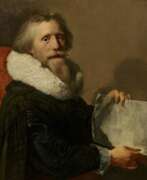

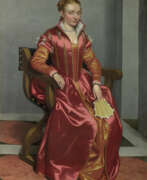

Giovanni Battista Moroni was an Italian painter of the Late Renaissance period. He also is called Giambattista Moroni. Best known for his elegantly realistic portraits of the local nobility and clergy, he is considered one of the great portrait painters of sixteenth century Italy.


Cornelis Cornelisz. van Haarlem was a Dutch painter, draftsman, and architect. Along with Karel van Mander and Hendrik Goltzius, he is one of the leading artists of the Dutch Mannerism of the Haarlem School, more commonly referred to as Cornelis van Haarlem.


Jacopo Palma the Elder, born in 1480, was an illustrious Italian painter whose work left an indelible mark on the Venetian Renaissance. Renowned for his vibrant colors, dramatic compositions, and adept storytelling, Palma the Elder was a master of both religious and secular themes, embodying the splendor of Venice in his canvases.
Known for his profound influence on the development of Venetian painting, Palma's art is celebrated for its dynamic use of light and shadow, a characteristic that would come to define the Venetian style. His ability to infuse scenes with emotional depth and realism drew viewers into his narratives, making his works compelling for both contemporary audiences and modern viewers.
Among his most notable works are his altarpieces, which grace many of Venice's storied churches, showcasing his skill in depicting sacred subjects with reverence and majesty. His portraits and mythological scenes are equally esteemed, housed in some of the world's most prestigious museums and galleries. These pieces not only highlight his technical prowess but also his versatility as an artist.
For collectors and experts in art and antiques, Jacopo Palma the Elder represents a pivotal figure whose contributions to the Renaissance continue to captivate and inspire. His paintings offer a window into the rich cultural and artistic milieu of early 16th-century Venice, making them highly sought after for their beauty and historical significance.
To discover more about Jacopo Palma the Elder and to stay updated on opportunities to view or acquire his works, signing up for updates is a must. This subscription will ensure you're informed about the latest exhibitions, sales, and auctions related to this master's oeuvre, enriching your understanding and appreciation of Venetian art.


Iacopo Negretti, best known as Jacopo or Giacomo Palma il Giovane or simply Palma Giovane ("Young Palma"), was an Italian painter from Venice and a notable exponent of the Venetian school. After Tintoretto's death (1594), Palma became Venice's dominant artist perpetuating his style. Outside Venice, he received numerous commissions in the area of Bergamo, then part of the Venetian Domini di Terraferma, and in Central Europe, most prominently from the connoisseur emperor Rudolph II in Prague. Rejecting Mannerism in the 1580s, he embraced a reformist naturalism.[6] He varied the ingeniously synthesised amalgam according to subject matter and patrons' own eclectic and conservative tastes, with "virtuoso skill and a facile intelligence". Palma il Giovane went on to organize his own, large studio which he used to produce a repetitive series of religious and allegorical pictures that can be found throughout the territory of the Venetian Republic.


Parmigianino, an Italian Mannerist painter born Girolamo Francesco Maria Mazzola, was a pivotal figure in the development of the Mannerist style, known for his sophisticated and elegant approach to painting. He was a leading figure in Parma's art scene following Correggio and had a significant influence on the artistic developments during the post-High Renaissance period through his expressive and stylish works.
Parmigianino's journey as an artist took him from Parma to Rome and then to Bologna, with his last years spent in Parma. His works, including the renowned "Madonna with the Long Neck," display a unique blend of grace and elegance, coupled with an idiosyncratic use of elongation and distortion, typical of Mannerist aesthetics. This painting, in particular, is noted for its unusual composition and the elongation of figures, embodying the Mannerist style's departure from the proportional norms established during the Renaissance.
He was also an early Italian etcher, utilizing this technique to express the spontaneity of an artist's hand. His etchings and drawings had a considerable influence on printmaking and the visual arts in Italy and Europe. In addition to his paintings, Parmigianino's contributions to the arts include his work in the church of the Steccata in Parma and his innovative approach to integrating painting with architectural elements.
For art collectors and experts, Parmigianino's work represents a critical link between the High Renaissance and the emergence of Baroque and Rococo styles, offering a unique insight into the evolution of European art. His works continue to be celebrated for their originality and mastery, making him a subject of enduring interest in the study of art history.
For those interested in exploring Parmigianino's contributions to art further, subscribing to updates from art institutions or platforms specializing in Renaissance and Mannerist art could provide valuable insights into his life, works, and ongoing exhibitions or sales of his artworks.


Pinturicchio, real name Bernardino di Betto di Biagio, was an Italian Renaissance painter.
Pinturicchio was a representative of the Umbrian Quattrocento school. He studied with Fiorenzo di Lorenzo, and together with Raphael with Perugino, who helped him paint the frescoes in the Sistine Chapel at the Vatican (1481-1482). As a mature master, Pinturicchio rejected some of Perugino's principles - the monotony and gradualness of the figures, the unity of time and place - which brings him rather closer to Botticelli.
His best known murals are in the churches of Santa Maria del Popolo, Santa Maria in Araceli and the Borgia Apartments in Rome, and in Siena Cathedral (Piccolomini Library). The frescoes of this artist's works often feature 'grotesques'. Of the easel paintings, 'Portrait of a Boy' from the Old Masters Gallery in Dresden is noteworthy.


Bernardino Poccetti also known as Barbatelli, was an Italian Mannerist painter and printmaker of etchings. He was initially trained as a decorator of facades and ceilings, enrolling in 1570 in the Florentine painters guild for such work. In 1592–93, he worked on frescoes in the Certosa di Galluzzo relating to Life and Death of San Bruno. He painted scenes from the life of founder of the Convent of the Servites for the Annunziata. In his later works, he is considered one of the Florentine reformers—the so-called Counter-Maniera (Counter-Mannerism).


Frans Pourbus the Younger was a Flemish artist, renowned for his sophisticated portraiture, who gained prominence for his meticulous depiction of opulent costumes, jewelry, and drapery. Born in Antwerp in 1569 into a family with a rich artistic lineage, Pourbus honed his craft in the vibrant cultural milieu of the time. His grandfather, Pieter Pourbus, was a leading portrait and history painter in Bruges, while his father, Frans Pourbus the Elder, was a significant figure in portrait and genre painting. The younger Pourbus’s artistry was characterized by its attention to detail rather than the exploration of dramatic scenes or landscapes, a style that resonated with the sensibilities of the courts he served.
Pourbus's career flourished as he became a court painter to influential figures such as Archduke Albert and Infanta Isabella in Brussels. His reputation for producing portraits that were aesthetically pleasing to his patrons propelled him to work for Vincenzo Gonzaga, Duke of Mantua, and subsequently, Marie de' Medici, Queen of France, in Paris. His works are preserved in prestigious collections across Europe, including the Louvre, the Prado, the Rijksmuseum, and the Metropolitan Museum of Art. Notable pieces such as the portrait of Eleonora de' Medici Gonzaga and the Infanta Isabella Clara Eugenia of Spain exemplify his skill in capturing the grandeur of the European aristocracy of the 17th century.
Art collectors and antiquities experts who admire the grandiose style of early European court portraiture find in Pourbus's work a quintessential representation of the era's aesthetics. His paintings, replete with detailed costume and adornment, provide a window into the past's lavishness and serve as enduring artifacts of cultural heritage. For updates on new product sales and auction events related to Frans Pourbus the Younger, signing up for our newsletter is a discreet and direct way to stay informed.


Cristoforo Roncalli was an Italian mannerist painter. He was one of the three painters known as Pomarancio or Il Pomarancio. Most of his fresco work was in Rome, though he worked for a decade in Loreto, where he decorated the New Sacristy.


Matteo Rosselli was an Italian painter of the late Florentine Counter-Mannerism and early Baroque. He is best known however for his highly populated grand-manner historical paintings. He first apprenticed with Gregorio Pagani. On 26 February 1599, he was inducted to the Accademia del Disegno, and in 1605 traveled to Rome to work with Domenico Passignano for six months. He completed some frescoes on The Legend of the Origin of the Servite Order in the Palazzo Pitti and in the Cloister of the Basilica della Santissima Annunziata; a Madonna and child with St Francis altarpiece for the Church of Santa Maria Maggiore in Florence.


Vincenzo Rustici was an Italian painter active in Siena. He was known for his religious compositions as well as his vedute showing public celebrations in Siena. Vincenzo Rustici was also a painter of history subjects. He is now mainly known for two canvases depicting respectively the Palio di Siena and the Procession of the Contrade in the Piazza del Campo held on 15 August 1546. These works provide an important record of these public festivities at the time. Rustici created a number of depictions of the Madonna and Child with saints.


Arcangelo Salimbeniwas an Italian painter of the Renaissance period active in his native Siena, Italy. He was the father of the painter Ventura Salimbeni, stepfather of Francesco Vanni, and son of Leonardo. He was a follower of Domenico Beccafumi and Il Sodoma, and influenced by Federico Zuccaro. He painted in a delicate, often diaphonous Mannerist style.


Carlo Saraceni was an Italian painter, renowned for his contributions to the Baroque art movement. Born in Venice around 1579, Saraceni spent a significant portion of his career in Rome, where he was deeply influenced by the works of Caravaggio and Elsheimer. His art is celebrated for its vivid naturalism and meticulous detail, reflecting the stylistic transitions of early 17th-century Italian painting.
Saraceni's ability to blend Venetian colorism with Roman naturalism allowed him to create works that resonated with patrons across Europe, securing commissions from prominent ecclesiastical and aristocratic figures. His paintings, such as "Judith and the Head of Holofernes" at the Kunsthistorisches Museum in Vienna and "Saint Sebastian" at the Picture Gallery of the Prague Castle, showcase his mastery in depicting biblical and mythological scenes with emotional depth and realism.
Notably, Saraceni's work "The Dormition of the Virgin" was commissioned to replace a rejected painting by Caravaggio, indicating his stature and recognition in the artistic community of Rome. This commission highlights the nuanced differences in interpretation and representation of religious themes that distinguished Saraceni's approach from Caravaggio's.
Throughout his career, Saraceni remained connected to the vibrant artistic scene in Rome, engaging with the broader European context through his international relations. His legacy is preserved in the numerous works held in galleries and museums worldwide, reflecting his enduring influence on the Baroque art movement.
For art collectors and experts, Saraceni's oeuvre represents a pivotal moment in the transition of artistic styles, offering a rich tapestry of themes and techniques that continue to inspire and captivate audiences.
To stay updated on new product sales and auction events related to Carlo Saraceni's works, consider signing up for updates. This subscription is a great way to remain informed about opportunities to engage with the art and legacy of this influential Baroque painter.


Giovanni Girolamo Savoldo was an Italian High Renaissance painter active mostly in Venice, although he also worked in other cities in northern Italy. He is noted for his subtle use of color and chiaroscuro, and for the sober realism of his works, which are mostly religious subjects, with a few portraits. His portraits are given interest by their accessories or settings; "some even look like extracts from larger narratives".
About 40 paintings by Savoldo are known in all, six of them portraits; only a handful of drawings by him are known. He was highly regarded in his own lifetime; several repetitions of works were commissioned from him, and copies of his work made by others. He slipped from general awareness, however, and many of his works were assigned to more famous artists, especially Giorgione, by the art trade. Awareness of his oeuvre revived in the 19th century, though the dating of many paintings remains controversial among specialists.


Andrea Semini was an Italian painter of the late-Renaissance, active mainly in his native Genoa. He was a son and pupil of the painter Antonio Semini. After studying some time under his father, together with his brother Ottavio he went to Rome, and they realized some work in collaboration (frescoes in the Palazzo Marino in Milan). He is well known for his frescoes in several palaces in Genoa, painting for churches and portraits.
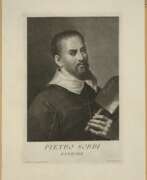

Pietro Sorri was an Italian painter active in Siena. He first studied under Arcangelo Salimbeni and afterwards under Cavaliere Domenico Passignano. Several of his works are in Florence and other cities of Tuscany, particularly at Pisa; he painted landscapes and portraits as well as history. He painted an altarpiece for the church of San Ambrogio in Massa di Carrara.


Lazzaro Tavarone was an Italian painter of the late-Renaissance and Mannerist period, active mainly in his native Genoa and in Spain. He was the pupil of the painter Luca Cambiasi. Tavarone accompanied Cambiaso to Spain in 1583, and helped decorate the Escorial for the Spanish King, including the chaotic battle painting of Battle of La Higueruela. He returned to Genoa in 1594, where he became well known both as portrait and history painter.
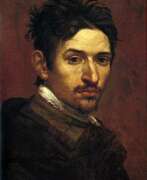

Alessandro Tiarini was an Italian Baroque painter of the Bolognese School. He was the godson of painter Lavinia Fontana and initially apprenticed in Bologna under her father Prospero Fontana, and subsequently with Bartolomeo Cesi. He was not inducted into the Carracci Academy. Forced to flee from Bologna, he moved to Florence, where he painted frescoes, façade decorations, and altarpieces. He painted a series of frescoes for the Brami Chapel in the sanctuary, as well as other works, for the Basilica della Ghiara in Reggio Emilia.


